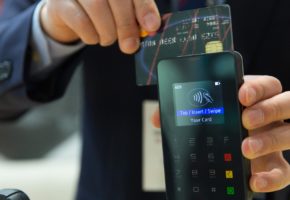
The growth of online money transfer services and other convenient Internet-based financial utilities has remained strong for over 5 years, and that trend does not look like it is slowing down. A 2014 Federal Reserve study found that the percentage of mobile banking users had grown from 28 percent in 2012 to 33 percent in 2013. That number only seems to be growing as Millennials and Generation X’ers get more comfortable with Internet-based banking services.
These trends are a worldwide phenomenon in developed countries. In addition to the United States, mobile banking is on the rise in the EU as well. As The Guardian has reported, payments via mobile banking apps increased 54% for Britons in 2015, and traditional banking services have been shrinking. This has only intensified over the last two years.
What do these mobile banking services look like, and what is driving these trends? Let’s take a look at the rise of mobile banking and some of the challenges faced by the financial and tech companies that provide these services.
A New Way to Bank
Mobile banking is simply the logical progression after years of development in the online money transfer services sector. Due to the explosive growth in eCommerce markets, various online payment services had to be developed to facilitate online transactions with credit cards. Payment gateways and other technologies were developed in order to securely circulate financial information between customers, merchants, and banking institutions.
As greater amounts of businesses and customers became comfortable with various Internet services, more and more banks moved to offer their own banking services that could be accessed via web browsers, and which could interface with the various online money transfer services.
Now, customers can do most of their banking through online services. Bank customers can check their balances, transfer funds instantly, monitor their checking accounts, deposit checks, and more. Online transfer services are often even more flexible and can be fully integrated with customers’ bank accounts, allowing them to transfer money to peers or businesses, and order products and services more securely online.
Additionally, all of these financial services are now available to customers in the literal palms of their hands. Sophisticated mobile apps bring online banking and online money transfer services straight to customers’ smartphones.
Why Mobile Banking?
 One positive aspect of mobile banking is apparent immediately. Customers no longer have to travel to financial institutions, wait in line, or deal with bank staff to take care of their financial needs. Bank accounts, payment transfers, online shopping, and other commercial activities are instantly accessible from anywhere via Internet browsers and mobile apps.
One positive aspect of mobile banking is apparent immediately. Customers no longer have to travel to financial institutions, wait in line, or deal with bank staff to take care of their financial needs. Bank accounts, payment transfers, online shopping, and other commercial activities are instantly accessible from anywhere via Internet browsers and mobile apps.
Besides the sheer convenience and expedience of mobile banking and online money transfer services, there are many other reasons that individuals are flocking to these mobile systems. In general, Millennials have grown up with the Internet in every part of their lives, and they are very comfortable with Internet interfaces. Even tech-savvy Generation X’ers have taken to utilizing online services, and many simply prefer the intuitive interfaces of web browsers and mobile apps that can perform services instantly.
Many consumers are also wary of bank branches and the endless hidden fees and aggressive sales pitches of personal bankers. This makes online services more appealing as they allow customers to see everything that is going on in their bank account, letting them quickly cut to the chase and take care of their financial matters while using a simple cut-and-dry interface.
Online money transfer services also allow more sophisticated alert systems and algorithms which combat fraud. Customers are better protected, and they are better informed when there are unauthorised advances on their bank accounts.
With the Internet providing customers with so many of their daily shopping, social, creative, informational, and entertainment needs, it makes sense to integrate financial services within this environment. Customers can simply pull up a new Internet tab or bring up a mobile app and take care of all of their banking needs on the fly.
New Challenges
 Despite all of these exciting developments, there are still challenges that face mobile banking and online financial services. Customers are well aware of the rising risks posed by increasingly bold and sophisticated cybercrime outfits. In fact, there is a group of customers who have held off on mobile banking services citing security concerns, and the size of that group is not insignificant. Though companies like Verizon are insisting that mobile banking vectors are not significant sources of cyber threats, there is a still a perception of compromised security that is turning many customers away.
Despite all of these exciting developments, there are still challenges that face mobile banking and online financial services. Customers are well aware of the rising risks posed by increasingly bold and sophisticated cybercrime outfits. In fact, there is a group of customers who have held off on mobile banking services citing security concerns, and the size of that group is not insignificant. Though companies like Verizon are insisting that mobile banking vectors are not significant sources of cyber threats, there is a still a perception of compromised security that is turning many customers away.
It is up to the providers of online money transfer services, financial institutions, and cyber security professionals to innovate on the security front and protect mobile customers from cyber-attacks. There are many customers who have already made the jump to mobile banking, but many more can be reached in the future when there is a clear perception of enhanced protection for many different types of Internet services. Future innovation in the mobile banking sector will likely feature significant investment in increased cyber security.
The Future of Mobile Banking
As a service, mobile banking is on the rise and is expected to continue growing significantly well into the future. Every generation from Gen X onwards uses the Internet to facilitate every aspect of their lives, and more customers are making the jump to mobile banking every day, especially among younger “digital natives” who see the Internet as a provider of essential services.
With new technologies and services come new challenges, and professionals in the mobile banking sector will definitely have their hands full addressing future industry trends. However, providers of online money transfer services and mobile banking apps are at the forefront of innovation, and the future of mobile banking looks bright. Expect enhanced security, better functionality, increased integration, and much more in the future.






